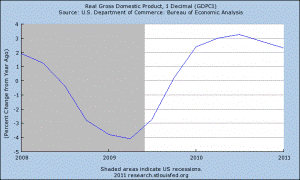高盛再次調(diào)低美國經(jīng)濟(jì)增長預(yù)期

|
????美國經(jīng)濟(jì)乏善可陳,,導(dǎo)致上周高盛(Goldman Sachs)經(jīng)濟(jì)學(xué)家們一個(gè)月內(nèi)第二次調(diào)低了美國經(jīng)濟(jì)增長的預(yù)期,,并警告稱“我們已經(jīng)預(yù)見到了這一預(yù)測走低的風(fēng)險(xiǎn)”,。 ????高盛最新預(yù)計(jì)2季度美國經(jīng)濟(jì)將以3%的速度蹣跚前行,,低于三周前預(yù)測的3.5%和年初預(yù)測的4%,。該公司同時(shí)預(yù)計(jì)4月份美國新增就業(yè)機(jī)會僅為15萬個(gè)——低于3月份的24.4萬個(gè),也顯著低于CNNMoney預(yù)測的17.8個(gè),。 ????高盛經(jīng)濟(jì)學(xué)家扎克?龐德爾概括常見因素認(rèn)為,,諸多因素導(dǎo)致了本輪經(jīng)濟(jì)增速放緩,其中包括高油價(jià),、日本大地震對制造業(yè)生產(chǎn)的沖擊及其他各種臨時(shí)性因素(如美國南方的龍卷風(fēng)和國防支出的減少)。 ????但他同時(shí)表示,僅憑這些因素很難解釋本應(yīng)相當(dāng)強(qiáng)勁的經(jīng)濟(jì)復(fù)蘇為何如此疲弱,。所有跡象都表明本輪增速放緩將是深層次的,,而不是暫時(shí)性的。 ????“某些特定因素看來確實(shí)重要,,但不能完全解釋近期數(shù)據(jù)的弱勢,美國經(jīng)濟(jì)增速看來的確已放緩,,”龐德爾在上周五致客戶的一份報(bào)告中寫道,,“我們同樣感到不解,因?yàn)?010年底時(shí)讓我們看到希望的很多趨勢——包括私營經(jīng)濟(jì)減債所取得的進(jìn)展,、更寬松的信貸和金融環(huán)境以及改善的勞動(dòng)市場——現(xiàn)在并沒有改變?!?/p> ????龐德爾指出,通過跟蹤新訂單,、銷售和發(fā)貨量、就業(yè),、材料價(jià)格和庫存制定的高盛分析師指數(shù)已跌至2010年春季放緩以來的新低;2010年春季的放緩直到美聯(lián)儲(Fed)承諾將通過所謂二次量化寬松政策的美國國債購買方案提升經(jīng)濟(jì)活力才結(jié)束,。也許你認(rèn)為美聯(lián)儲要結(jié)束量化寬松政策存在難度,持這種觀點(diǎn)的大有人在,。 ????高盛絕非近來唯一發(fā)出此類論調(diào)的公司。美國銀行美林(Bank of America Merrill Lynch)的經(jīng)濟(jì)學(xué)家們上周也將2季度美國經(jīng)濟(jì)增長率預(yù)測值調(diào)低至了2%,,并警告稱接踵而至的“黯淡”數(shù)據(jù)看來不太可能戛然而止,。 ????高盛去年底一度非常樂觀,如今卻公然下調(diào)前景,,透露出一絲不祥之兆——而且,有充分的理由相信還將有更多的壞消息傳來。說不準(zhǔn)哪一天,,本?伯南克就會碰到大麻煩。 ????“如果未來幾個(gè)月數(shù)據(jù)仍然不見改善,,”龐德爾說,,“我們可能需要考慮進(jìn)一步下調(diào)美國經(jīng)濟(jì)增長率預(yù)測值?!?/p> |
????So lukewarm that economists at Goldman Sachs last week cut their economic growth forecast for the second time in a month, only to warn a few days later that "we already see downside risk to that ????Goldman now sees the U.S. economy struggling to limp forth at a 3% pace in the second quarter, down from 3.5% just three weeks ago and 4% at the start of the year. The firm expects the economy to have added just 150,000 jobs in April – down from 244,000 in March and well below the 178,000 CNNMoney forecast. ????Economist Zach Pandl rounds up the usual suspects, blaming high oil prices, manufacturing disruptions triggered by the earthquake in Japan and various other temporary factors (such as tornadoes in the South and a drop in defense spending). ????But those alone can hardly account for all the slack in what was supposed to be a reasonably vigorous recovery by now, he says. All signs point toward a broad-based slowdown, rather than one tied to temporary factors. ????"Special factors do seem important, but they cannot explain all the recent weakness in the data, and the economy does seem to have slowed," Pandl writes in a note to clients Friday. "We are somewhat puzzled by this because many of the trends that made us more optimistic around yearend 2010—progress in private sector deleveraging, easier credit and financial conditions, and an improving labor market—are still in place." ????Pandl notes that the firm's analyst index – which tracks new orders, sales and shipments, employment, materials prices and inventories – has fallen to levels last seen during the spring 2010 slowdown that ended only when the Fed promised to stoke up activity with the bond-buying plan dubbed QE2. If you think the Fed is going to have trouble walking away from quantitative easing, you aren't alone. ????Goldman is hardly the only firm to be humming this tune lately. Economists at Bank of America Merrill Lynch last week cut their second-quarter growth forecast to 2%, warning that a run of "dreary" data doesn't seem likely to end suddenly. ????But Goldman was so bullish at the end of last year that a pronounced darkening in its outlook is ominous – and there is every reason to believe the bad news isn't over. Another day, another giant problem for Ben Bernanke. ????"If the data flow fails to improve in coming months," says Pandl, "we may need to consider a further downgrade to our US growth forecasts." |













